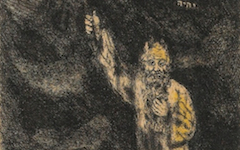Chagall as an Animal (20th century)

Chagall, The Painter and the Goat (c.1982) Tempera on canvas. Private Collection.
Click image to enlarge.
In this self-portrait by Marc Chagall, painted towards the end of his life, he placed his own figure behind a goat as if to say "I am the goat." Their heads seem to touch. Chagall's sense of identification with goats is a well-known aspect of his art. Here the goat's presence as the artist is signalled in various ways. One eye of the animal is placed horizontally, flat on the surface, as an artist's eye is often drawn in self-portraits. The painter's palette-arm cannot be seen though one leg of the goat extends towards the palette's thumb-hole as if the goat's leg and the painter's thumb are linked. In a third more obvious tactic, he wrote "Ch" on the palette, the first two letters of both his own name and chèvre, the French word for goat.
Click next thumbnail to conitinue
In Dawn from a decade earlier a goat plays the violin next to a female nude with two heads, Chagall's and his wife's. First note, though, that the goat looks up at the nude like an artist admiring his artwork. The nude figure is, of course, art's iconic subject thereby signalling that the nude, floating in space, is the goat-artist's painting. However, with Chagall's head, the painting of the nude is an androgynous self-representation because every painter paints himself. Titian's paintings of a musician with a nude Venus work in exactly the same way.1 Both aspects of this work - the music-playing artist and the nude as a painting - are very common but little-known features of art in the West.
Click next thumbnail to conitinue
In this drawing titled Painter at an Easel Chagall turned a horse's head into his torso. The artist and animal are one. He sits, legs extended, as though astride two circles: one his palette with brushes, the other the seat of his chair. On one level they represent two modes of perception, one with a pupil and ray-like brushes extending from it must be exterior vision while the other without a pupil will be insight. The circles are cropped as well, making them mirror-Cs, for Chagall and Cheval perhaps. He seems to be riding them too, punning on the French for easel, chevalet, which is derived from cheval, the word for horse. Many artists have imagined easels as horses because both have four legs. The title, Peintre au Chevalet, even sounds close in French to "Painter on horseback", Peintre au Cheval. This time he wrote "cha" on his palette as if to emphasize the aural homonym between Chagall and Cheval.
Click next thumbnail to continue
Chagall had a life-long sense of identification with goats and horses. This drawing, done half a century earlier than the previous three, depicts a horse on top of the artist's head as though in thinking a horse he becomes a horse. It is, like the others, a literal image of his imagination at work. We are looking into his mind.
Click next thumbnail to continue
The last example shows a man with a knife behind what looks like a cow though no udders are shown. It is clearly not a bull though it may be a horse. In the end it does not matter much. By placing the butcher behind his animal, the artist suggests they are united just as many mystical traditions believe that man and animal are one. The butcher is "the artist" using his knife to "draw" this composition. A butcher, after all, in similar language, draws his knife across an animal's neck. That is also why the blade touches the border. An artist's paintbrush is often positioned there in self-portraits because in turning to look in the mirror (the image we see) they paint to one side. Chagall thus identifies himself with both the butcher as artist and the man and animal together as his true Self.
1. See the entry Titian's Venus with an Organist
More Works by
Notes:
Original Publication Date on EPPH: 08 Sep 2011. | Updated: 0. © Simon Abrahams. Articles on this site are the copyright of Simon Abrahams. To use copyrighted material in print or other media for purposes beyond 'fair use', you must obtain permission from the copyright owner. Websites may link to this page without permission (please do) but may not reproduce the material on their own site without crediting Simon Abrahams and EPPH.





